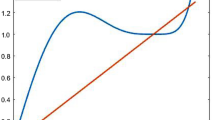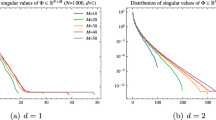Abstract
We study the problem of estimating the best k term Fourier representation for a given frequency sparse signal (i.e., vector) A of length N≫k. More explicitly, we investigate how to deterministically identify k of the largest magnitude frequencies of \(\hat{\mathbf{A}}\) , and estimate their coefficients, in polynomial(k,log N) time. Randomized sublinear-time algorithms which have a small (controllable) probability of failure for each processed signal exist for solving this problem (Gilbert et al. in ACM STOC, pp. 152–161, 2002; Proceedings of SPIE Wavelets XI, 2005). In this paper we develop the first known deterministic sublinear-time sparse Fourier Transform algorithm which is guaranteed to produce accurate results. As an added bonus, a simple relaxation of our deterministic Fourier result leads to a new Monte Carlo Fourier algorithm with similar runtime/sampling bounds to the current best randomized Fourier method (Gilbert et al. in Proceedings of SPIE Wavelets XI, 2005). Finally, the Fourier algorithm we develop here implies a simpler optimized version of the deterministic compressed sensing method previously developed in (Iwen in Proc. of ACM-SIAM Symposium on Discrete Algorithms (SODA’08), 2008).
Similar content being viewed by others
References
C. Anderson, M.D. Dahleh, Rapid computation of the discrete Fourier transform, SIAM J. Sci. Comput. 17, 913–919 (1996).
L.I. Bluestein, A linear filtering approach to the computation of discrete Fourier transform, IEEE Trans. Audio Electroacoust. 18, 451–455 (1970).
J.P. Boyd, Chebyshev and Fourier Spectral Methods (Dover, New York, 2001).
E. Candes, J. Romberg, T. Tao, Robust uncertainty principles: exact signal reconstruction from highly incomplete frequency information, IEEE Trans. Inf. Theory 52, 489–509 (2006).
E. Candes, J. Romberg, T. Tao, Stable signal recovery from incomplete and inaccurate measurements, Commun. Pure Appl. Math. 59(8), 1207–1223 (2006).
B. Chazelle, The Discrepancy Method: Randomness and Complexity (Brooks/Cole Publishing Company, 1992).
A. Cohen, W. Dahmen, R. DeVore, Compressed sensing and best k-term approximation, J. Am. Math. Soc. 22(1), 211–231 (2008).
J. Cooley, J. Tukey, An algorithm for the machine calculation of complex Fourier series, Math. Comput. 19, 297–301 (1965).
T.H. Cormen, C.E. Leiserson, R.L. Rivest, C. Stein, Introduction to Algorithms (MIT Press/McGraw–Hill, Cambridge/New York, 1990).
G. Cormode, S. Muthukrishnan, Combinatorial algorithms for compressed sensing. Technical Report DIMACS TR 2005-40 (2005).
G. Cormode, S. Muthukrishnan, Combinatorial algorithms for compressed sensing, in Conference on Information Sciences and Systems, March 2006.
I. Daubechies, O. Runborg, J. Zou, A sparse spectral method for homogenization multiscale problems, Multiscale Model. Simul. (2007).
R.A. DeVore, Deterministic constructions of compressed sensing matrices, J. Complex. 23 (August 2007).
D. Donoho, Compressed sensing, IEEE Trans. Inf. Theory 52, 1289–1306 (2006).
D.L. Donoho, J. Tanner, Thresholds for the recovery of sparse solutions via ℓ 1 minimization, in 40th Annual Conference on Information Sciences and Systems (CISS), 2006.
D.Z. Du, F.K. Hwang, Combinatorial Group Testing and Its Applications (World Scientific, Singapore, 1993).
A. Dutt, V. Rokhlin, Fast Fourier transforms for nonequispaced data, SIAM J. Sci. Comput. 14, 1368–1383 (1993).
D. Eppstein, M.T. Goodrich, D.S. Hirschberg, Improved combinatorial group testing algorithms for real-world problem sizes. http://arxiv.org/abs/cs.DS/0505048, May 2005.
J.A. Fessler, B.P. Sutton, Nonuniform fast Fourier transforms using min-max interpolation, IEEE Trans. Signal Proc. 51, 560–574 (2003).
G.B. Folland, Fourier Analysis and Its Applications (Brooks/Cole Publishing Company, 1992).
M. Frigo, S. Johnson, The design and implementation of fftw3, Proc. IEEE 93(2), 216–231 (2005).
A. Gilbert, M. Strauss, Group testing in statistical signal recovery. Preprint (2006).
A. Gilbert, S. Guha, P. Indyk, S. Muthukrishnan, M. Strauss, Near-optimal sparse Fourier estimation via sampling, in ACM STOC, pp. 152–161, 2002.
A. Gilbert, S. Muthukrishnan, M. Strauss, Improved time bounds for near-optimal sparse Fourier representations, in Proceedings of SPIE Wavelets XI, 2005.
A.C. Gilbert, M.J. Strauss, J.A. Tropp, R. Vershynin, Algorithmic linear dimension reduction in the l 1 norm for sparse vectors. Preprint (2006).
P. Indyk, Explicit constructions of selectors and related combinatorial structures, with applications, in SODA ’02: Proceedings of the Thirteenth Annual ACM-SIAM Symposium on Discrete Algorithms, pp. 697–704, Philadelphia, PA, USA, 2002. Society for Industrial and Applied Mathematics.
P. Indyk, Explicit constructions for compressed sensing of sparse signals, in Proc. of ACM-SIAM Symposium on Discrete Algorithms (SODA’08), 2008.
M.A. Iwen, A deterministic sub-linear time sparse Fourier algorithm via non-adaptive compressed sensing methods, in Proc. of ACM-SIAM Symposium on Discrete Algorithms (SODA’08), 2008.
M.A. Iwen, C.V. Spencer, Improved bounds for a deterministic sublinear-time sparse Fourier algorithm, in Conference on Information Sciences and Systems (CISS), 2008.
M.A. Iwen, A.C. Gilbert, M.J. Strauss, Empirical evaluation of a sub-linear time sparse DFT algorithm, Commun. Math. Sci. 5(4) (2007).
L.Y.E. Kaltofen, Improved sparse multivariate polynomial interpolation algorithms, in International Symposium on Symbolic and Algebraic Computation, 1988.
D. Kincaid, W. Cheney, Numerical Analysis: Mathematics of Scientific Computing (China Machine Press, 2003).
S. Kirolos, J. Laska, M. Wakin, M. Duarte, D. Baron, T. Ragheb, Y. Massoud, R. Baraniuk, Analog-to-information conversion via random demodulation, in Proc. IEEE Dallas Circuits and Systems Conference, 2006.
S. Kunis, H. Rauhut, Random sampling of sparse trigonometric polynomials II—orthogonal matching pursuit versus basis pursuit. Found. Comput. Math. 8(6), 737–763 (2008).
J. Laska, S. Kirolos, Y. Massoud, R. Baraniuk, A. Gilbert, M. Iwen, M. Strauss, Random sampling for analog-to-information conversion of wideband signals, in Proc. IEEE Dallas Circuits and Systems Conference, 2006.
J.-Y. Lee, L. Greengard, The type 3 nonuniform FFT and its applications, J. Comput. Phys. 206, 1–5 (2005).
M. Lustig, D. Donoho, J. Pauly, Sparse MRI: The application of compressed sensing for rapid MR imaging, Magn. Reson. Med. 58(6), 1182–1195 (2007).
R. Maleh, A.C. Gilbert, M.J. Strauss, Signal recovery from partial information via orthogonal matching pursuit, in IEEE Int. Conf. on Image Processing, 2007.
S. Mallet, A Wavelet Tour of Signal Processing (China Machine Press, 2003).
Y. Mansour, Learning boolean functions via the Fourier transform, Theor. Adv. Neural Comput. Learn. 391–424 (1994).
Y. Mansour, Randomized approximation and interpolation of sparse polynomials, SIAM J. Comput. 24, 2 (1995).
R. Motwani, P. Raghavan, Randomized Algorithms (Cambridge University Press, Cambridge, 1995).
S. Muthukrishnan, Data streams: algorithms and applications, Found. Trends Theor. Comput. Sci. 1 (2005).
S. Muthukrishnan, Some algorithmic problems and results in compressed sensing, in Allerton Conference, 2006.
D. Needell, R. Vershynin, Uniform uncertainty principle and signal recovery via regularized orthogonal matching pursuit, Found. Comput. Math. 9, 317–334 (2009).
I. Niven, H.S. Zuckerman, H.L. Montgomery, An Introduction to the Theory of Numbers (Wiley, New York, 1991).
L. Rabiner, R. Schafer, C. Rader, The chirp z-transform algorithm, IEEE Trans. Audio Electroacoust. AU-17(2), 86–92 (1969).
M. Rudelson, R. Vershynin, Sparse reconstruction by convex relaxation: Fourier and Gaussian measurements, in 40th Annual Conference on Information Sciences and Systems (CISS), 2006.
The Prime Pages, http://primes.utm.edu/.
J. Tropp, A. Gilbert, Signal recovery from partial information via orthogonal matching pursuit, IEEE Trans. Inf. Theory 53(12), 4655–4666 (2007).
Author information
Authors and Affiliations
Corresponding author
Rights and permissions
About this article
Cite this article
Iwen, M.A. Combinatorial Sublinear-Time Fourier Algorithms. Found Comput Math 10, 303–338 (2010). https://doi.org/10.1007/s10208-009-9057-1
Received:
Revised:
Accepted:
Published:
Issue Date:
DOI: https://doi.org/10.1007/s10208-009-9057-1
- Trigonometric approximation and interpolation
- Discrete and fast Fourier transforms
- Approximation algorithms




